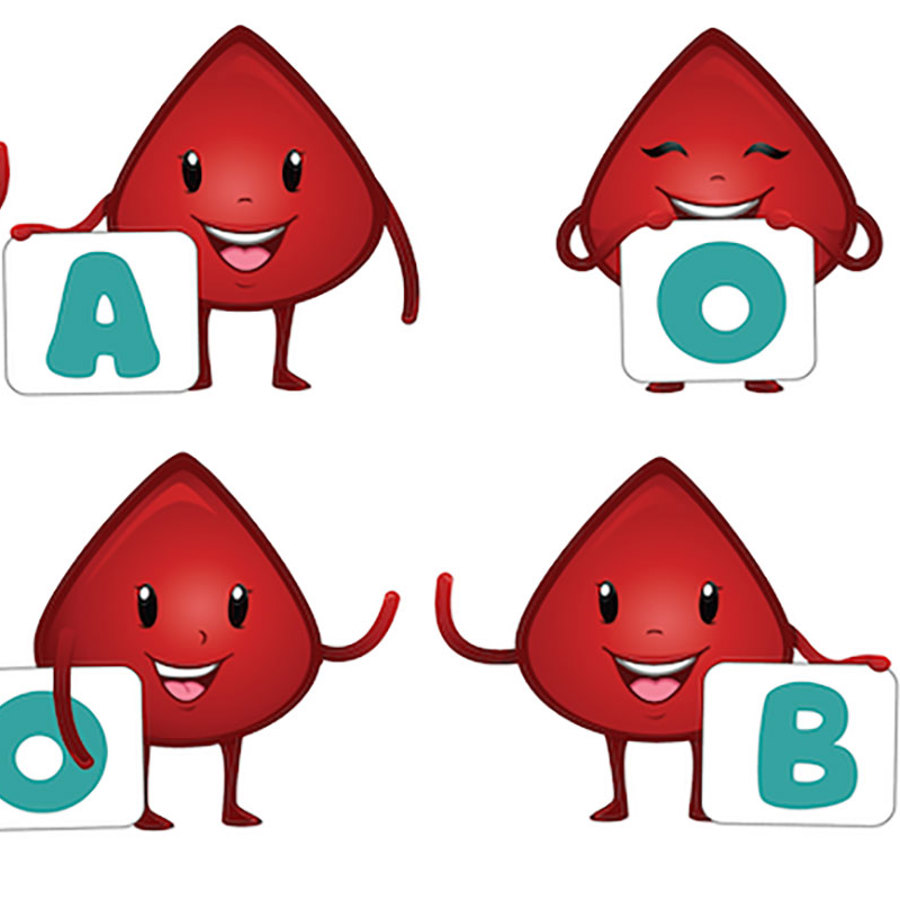
How is blood type inherited? And do exceptions ever happen?
March 18, 2022

- Related Topics:
- Common questions,
- Blood type,
- ABO blood type,
- Rh factor,
- Bombay blood group,
- Cis AB blood type,
- Chimera,
- Rare events
Many people from all around the world ask:
“How is blood type inherited? And do exceptions ever happen?”
Typical blood type inheritance
In the vast majority of cases, blood type follows a predictable inheritance pattern. Here are a child’s possible blood types for any two parents:
|
Parent 1 |
Parent 2 |
Child’s possible |
|
A |
A |
A, O |
|
A |
B |
A, B, AB, O |
|
A |
AB |
A, B, AB |
|
A |
O |
A, O |
|
B |
B |
B, O |
|
B |
O |
B, O |
|
B |
AB |
A, B, AB |
|
AB |
AB |
A, B, AB |
|
AB |
O |
A, B |
|
O |
O |
O |
|
Parent 1 |
Parent 2 |
Child’s possible |
|
+ |
+ |
+ or - |
|
+ |
- |
+ or - |
|
- |
- |
- |
Note that the ABO part is in a separate table from the +/- part. These two things are determined by two different genes and are inherited separately.
More about ABO blood type:
- Why do children sometimes have different blood types from their parents?
- How is ABO blood type passed on?
- Does blood type matter for pregnancy?
- How many blood types are there?
More about Rh blood type:
- How do I have Rh negative-type blood, when both my parents are positive?
- Why do some Rh negative moms have pregnancy complications?
- Why are Rh blood tests sometimes inaccurate?
- How did Rh factor evolve?
Help! My child’s blood type doesn’t make sense
1. Double check the blood types
Humans make a lot of mistakes, so this is always worth double checking before you go any farther. It’s actually very common for people to misremember their blood type. And sometimes people have an error in their test results, due to some mixup in the lab.
An especially common blood typing error is incorrectly determining someone’s Rh type. Sometimes a test won’t detect that someone is actually Rh+, incorrectly labeling them as Rh-. This is one way that two negative-type parents could have a positive-type child. (Read more about Rh test accuracy.)
In any case, ask your health care provider for a blood type test. Or donate blood to your local blood bank, as they’ll generally send you your blood type information afterwards.
2. Consider confirming parentage
The blood type inheritance pattern is very predictable. While blood type was often used during the early 1900s as a rudimentary paternity test, today more reliable tests like paternity tests or ancestry-type tests should be used to confirm or reject parentage.
3. Don’t jump to conclusions, exceptions can happen
Like with everything in biology, sometimes there are exceptions to the patterns mentioned above. See below for some of the ways to break the blood type inheritance rules.
Rare exceptions to the blood type inheritance rules
Chimerism
A chimera is a person who has two different sets of DNA, from two different individuals. If the DNA in the blood isn’t the same as the DNA in the sperm/eggs, a child might inherit an unexpected type.
Chimerism can happen in a few different ways:
- Bone marrow transplant. A bone marrow transplant recipient will have the blood type of the donor. But their sperm/eggs will still have the recipient’s original DNA and blood type.
- Fusion chimerism. This is when a twin pregnancy combines into a single fetus with a combination of both twins’ sets of DNA. If the blood type is made by one “twin” while the sperm/eggs are made by the other “twin”, unexpected inheritance patterns can happen. Only about 100 cases of chimerism have been reported1, though as it often goes undetected the true frequency is unknown. It is theorized to be more common in people born via IVF.2
- Blood chimerism. This is when fraternal twins share some blood during pregnancy, causing one or both twins to have mixed blood cells. This can cause a different blood type than the DNA in the sperm/egg cells. Around 1 in 12 twin pairs and 1 in 5 triplet pairs show blood chimerism3.
Read more on chimerism and blood chimerism.
Cis-AB blood type
This rare blood type is caused by a fourth version of the ABO gene, which can cause Type AB all by itself. This can make it possible for an AB parent to have an O child, and an AB parent + O parent to have an AB child. This blood type is most common in some southeast Asian populations like Korea (1 in 3,000 people) and Japan (1 in 80,000 people)4. Read more on cis-AB blood type.
Bombay blood group
This rare, recessive blood type is caused by a variant at a different blood type gene. People with this blood type look like Type O, no matter which versions of the ABO gene they have. This blood type is most common in Taiwan (1 in 8,000 people) and India (1 in 10,000 people)5. Read more on Bombay blood group.
New mutations
This is the rarest possibility mentioned so far, and may be difficult to confirm aside from ruling out the other possibilities. Read more on blood type mutations.
Uniparental disomy
This one is also very rare. There are documented examples where a child inherits both copies of a chromosome from a single parent6. If this happened with the chromosome that contains the blood type genes, you could theoretically inherit your blood type entirely from one parent. Read more on uniparental disomy.
Applying the rare exceptions to different scenarios
The chart below does not cover every scenario. For example, it does not include mutation and uniparental disomy, as they have the fewest documented examples of blood type rule breaking.
|
Parent 1 |
Parent 2 |
Expected blood type for a child |
How an exception could happen |
|
A |
A |
A, O |
B: Possible if either parent is a chimera AB: Possible if either parent is a chimera |
|
A |
B |
A, B, AB, O |
N/A |
|
A |
AB |
A, B, AB |
O: Possible if the AB parent is a chimera or has cis-AB blood type. Also possible if both parents are carriers of Bombay blood group. |
|
A |
O |
A, O |
B: Possible if either parent is a chimera, or if the O parent has Bombay blood group AB: Possible if the O parent is a chimera or has Bombay blood group |
|
B |
B |
B, O |
A: Possible if either parent is a chimera AB: Possible if either parent is a chimera |
|
B |
O |
B, O |
A: Possible if either parent is a chimera, or if the O parent has Bombay blood group AB: Possible if the O parent is a chimera or has Bombay blood group |
|
AB |
AB |
A, B, AB |
O: Possible if both parents are carriers of Bombay blood group, or if both have the cis-AB blood type. |
|
AB |
O |
A, B |
O: Possible if the AB parent is a chimera or has cis-AB blood type. Also possible if both parents are carriers of Bombay blood group. AB: Possible if the AB has cis-AB blood type. Also possible if the O parent has Bombay blood group. |
|
O |
O |
O |
A: Possible if either parent is a chimera or has Bombay blood group. B: Possible if either parent is a chimera or has Bombay blood group. AB: Would require both parents to either be a chimera or have Bombay blood group. |
Read more about: Chimerism, Bombay Blood Group, or cis-AB blood type.
|
Parent 1 |
Parent 2 |
Expected blood type for a child |
How an exception could happen |
|
+ |
+ |
+ or - |
N/A |
|
+ |
- |
+ or - |
N/A |
|
- |
- |
- |
+ : Possible if either parent has a slightly different Rh variant (weak D or partial D), or if either is a chimera. |
Read more about: Rh variants and chimerism.
Read More:
Examples of classic blood type inheritance:
- Why do children sometimes have different blood types from their parents?
- My mother is blood type A, my father is type O, and I’m type O. Is this possible?
- Can twins have two different blood types?
- Can two Rh+ parents have an Rh- child?
Examples of breaking the blood type inheritance rules:
- Can two Type A parents have an AB child?
- Can an AB parent have an O child?
- Can an O parent have an AB child?
- Can two Rh- parents have an Rh+ child?
- The story of Lydia Fairchild, a mother who received a DNA test saying her children were not her own. Eventually, genetic tests proved she had chimerism.

Author: Abbey Thompson, PhD
Abbey served as The Tech Geneticist from 2018-2024, answering thousands of questions submitted by people from all around the world, and overseeing all articles published during her tenure. Ask-a-Geneticist is part of the Stanford at The Tech program, which brings Stanford scientists to The Tech Interactive to run genetics activities with visitors in the BioTinkering Lab.
 Skip Navigation
Skip Navigation
